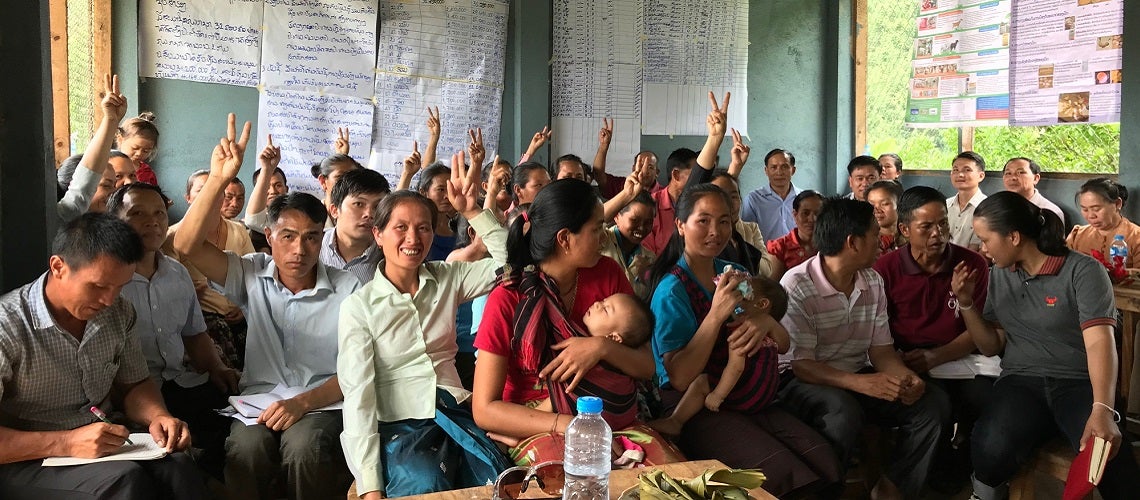 Self Help Groups members raise their hands to indicate how many livelihood loans they have borrowed from the group savings. Hiem District, Houaphanh Province, Lao PDR
Self Help Groups members raise their hands to indicate how many livelihood loans they have borrowed from the group savings. Hiem District, Houaphanh Province, Lao PDR
Global leaders are gathering in Kunming, China, and Glasgow, UK, to address the biodiversity and climate crises. And while there is growing recognition of the interlinkages between the two, a key aspect that has not received enough attention is the need to put people at the center in finding solutions. This reckoning in the climate and biodiversity arenas has been met more recently with the realization that green, resilient, and inclusive recovery from COVID-19 and the related economic crises will also require much stronger efforts to reduce inequalities and strengthen social inclusion. Local communities, including the Indigenous Peoples that occupy the most biodiverse areas of the world, will be central to tackling this two-fold crisis.
Conservationists have proposed ambitious actions for the Post-2020 Global Biodiversity Framework. These Proposals include the widely publicized target of “30 by 30” calling for 30 percent of the terrestrial and marine surface of the planet to be under conservation by 2030, and to be managed effectively and equitably. A recent report by a consortium of international conservation organizations noted that achieving this ambitious goal “will not be possible without the lands and territories recognized, sustained, protected and restored” by Indigenous Peoples and local communities. But these communities often lack voice in their own development or in the use of their land. Too often, Indigenous Peoples in particular live in poverty, their cultural identity and survival under threat, and unable to enjoy the benefits of the many global initiatives whose goals they share.
Quite simply, there is no path to achieving our climate goals without contributions from local communities and the carbon stored on their lands. Globally, forests store about 640 gigatons of carbon (GtC), and, of that amount, at least 293 GtC is stored on lands occupied or claimed by local communities, many of which are those of Indigenous People. If that carbon were released, the emissions would equal 33 times all global energy emissions in 2017. Local people and communities can play a major role in preventing that from happening by acting as stewards to the lands they occupy, use, and manage. To do so, they will need global and local efforts to secure their land rights as well as technical resources and investments that will improve their lives.
For all these reasons, it is time to include local communities and people as active partners in developing solutions at scale to address the interrelated biodiversity and climate crises. In fact, local communities, particularly Indigenous People, own, occupy, or use a quarter of the world’s surface area, including 40% of the world’s ecologically intact landscapes. A recent review found that, globally, “91% of lands occupied by Indigenous People are in good or moderate ecological condition, providing evidence that local peoples’ custodianship is consistent with the conservation of biodiversity”.
"It is time to include local communities and people as active partners in developing solutions at scale to address the interrelated biodiversity and climate crises. "
Globally, we now know many ways to give voice and empower local communities in our efforts to fight climate change and improve lives. The World Bank has decades of experience supporting governments in implementing community-driven development approaches that put local people at the center, In Indonesia, we are building on a long legacy of community development programs by supporting government to improve investments across 75,000 villages that includes community awareness of local climate and environmental risks as part of setting their own investment priorities. We also have experience supporting land titling and tenure rights of individuals and local communities. The land administration program in Nicaragua, for example, provided land titles to more than 100,000 Indigenous Peoples as well as titling of all 23 ancestral territories, equivalent to 30 percent of the total national territory. Now is the time for us to work with governments to scale up these successes.
Other actors have also been stepping up their efforts. Recently, a group of private donors committed US $5 billion to achieve the “30 by 30” target and simultaneously pledged to support the role of local communities, especially Indigenous People. A new network of public and private donors called Path to Scale has also been working to facilitate new funding commitments, including a $1.7 billion pledge at COP26 in support of Indigenous Peoples and local communities to protect tropical forests. While encouraging, these efforts need to be linked to government policies and programs to be effective.
The world will be watching leaders at the Biodiversity and Climate Change CoPs and beyond to see whether they, and their institutions, are ready to embrace this effort. This is an opportunity for the international community to come together around climate action and conservation, using all its instruments—including policy dialogue, knowledge and research, and financing—to put people and local communities at the center of the solutions to the twin global crises.
Related:
Social Dimensions of Climate Change at the World Bank
Social Sustainability and Inclusion at the World Bank
Climate Change at the World Bank
Environment at the World Bank
Joint Donor Statement - UN Climate Change Conference (COP26) at the SEC – Glasgow 2021


Join the Conversation